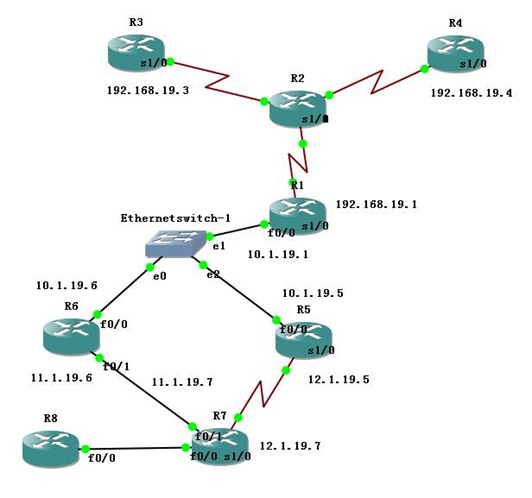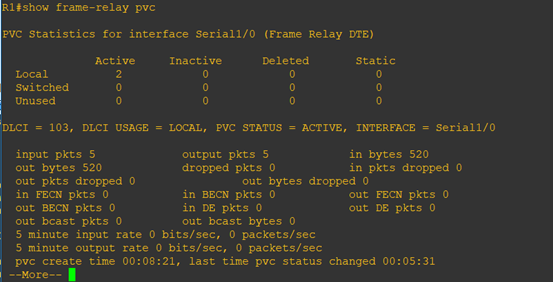一、实验目的
1. 掌握 OSPFv3(v2) 的配置方法
2. 掌握在帧中继环境下 OSPFv3 (v2)的配置方法
3. 掌握 OSPFv3(v2) NSSA 的配置方法
4. 掌握外部路由汇总的配置
5. 掌握区域间路由的汇总配置
二、OSPFv2实验拓扑图

三、OSPFv2网络地址规划
IPv4地址表
| Device |
Interface |
IP Address |
| R1 |
F0/0 |
10.1.19.1 |
| S1/0 |
192.168.19.1 |
|
| R3 |
S1/0 |
192.168.19.3 |
| R4 |
S1/0 |
192.168.19.4 |
| R5 |
F0/0 |
10.1.19.5 |
| S1/0 |
12.1.19.5 |
|
| R6 |
F0/0 |
10.1.19.6 |
| F0/1 |
11.1.19.6 |
|
| R7 |
F0/1 |
11.1.19.7 |
| S1/0 |
12.1.19.7 |
|
| R8 |
|
|
|
|
|
四、OSPFv2配置步骤
步骤1:开启R2帧中继交换功能
R2(config)#frame-relay switching
步骤2:配置各接口封装
R2(config)#interface Serial 1/2
R2(config-if)#no shutdown
R2(config-if)#clock rate 128000
R2(config-if)#encapsulation frame-relay
R2(config)#interface Serial 1/0
R2(config-if)#no shutdown
R2(config-if)#clock rate 128000
R2(config-if)#encapsulation frame-relay
R2(config)#interface Serial 1/1
R2(config-if)#no shutdown
R2(config-if)#clock rate 128000
R2(config-if)#encapsulation frame-relay
步骤3:配置LMI类型
R2(config)#interface Serial 1/2
R2(config-if)#frame-relay lmi-type cisco
R2(config-if)#frame-relay intf-type dce
R2(config)#interface Serial 1/0
R2(config-if)#frame-relay lmi-type cisco
R2(config-if)#frame-relay intf-type dce
R2(config)#interface Serial 1/1
R2(config-if)#frame-relay lmi-type cisco
R2(config-if)#frame-relay intf-type dce
步骤4:配置帧中继交换表
R2(config)#interface Serial 1/2
R2(config-if)#frame-relay route 103 interface Serial 1/0 301
R2(config-if)#frame-relay route 104 interface Serial 1/1 401
R2(config)#interface Serial 1/0
R2(config-if)#frame-relay route 301 interface Serial 1/2 103
R2(config)#interface Serial 1/1
R2(config-if)#frame-relay route 401 interface Serial 1/2 104
此时执行命令“show frame-relay route”来检查帧中继交换机是否正常:

步骤5:配置R1、R3、R4,使得它们能够互相通信
R1(config)#interface Serial 1/0
R1(config-if)#ip address 192.168.19.1 255.255.255.0
R1(config-if)#no shutdown
R1(config-if)#encapsulation frame-relay
R1(config-if)#frame-relay lmi-type cisco
R1(config-if)#no frame-relay inverse-arp //关闭自动映射
R1(config-if)#frame-relay map ip 192.168.19.3 103 broadcast
R1(config-if)#frame-relay map ip 192.168.19.4 104 broadcast
R3(config)#interface Serial 1/0
R3(config-if)#ip address 192.168.19.3 255.255.255.0
R3(config-if)#no shutdown
R3(config-if)#encapsulation frame-relay
R3(config-if)#no frame-relay inverse-arp
R3(config-if)#frame-relay map ip 192.168.19.1 301 broadcast
R4(config)#interface Serial 1/0
R4(config-if)#ip address 192.168.19.4 255.255.255.0
R4(config-if)#no shutdown
R4(config-if)#encapsulation frame-relay
R4(config-if)#no frame-relay inverse-arp
R4(config-if)#frame-relay map ip 192.168.19.1 401 broadcast
执行ping命令测试:
R1 ping R3与R4

在R1执行命令“show frame-relay PVC”

显示存在两条本地连接。
步骤6:开始配置OSPF
先配置外部路由器OSPF(配置以R6、R1为例,R5、R7同理)
R6(config)#router ospf 1
R6(config-router)#router-id 6.6.6.6
R6(config-router)#area 1 nssa //配置区域 1为 NSSA 区域
R6(config)#interface loopback 0
R6(config-if)#ip address 6.6.6.6 255.255.255.255
R6(config)#interface FastEthernet 0/0
R6(config-if)#ip address 10.1.19.6 255.255.255.0
R6(config-if)#no shutdown
R6(config-if)#ip ospf 1 area 0
R6(config-if)#interface FastEthernet 0/1
R6(config-if)#ip address 11.1.19.6 255.255.255.0
R6(config-if)#no shutdown
R6(config-if)#ip ospf 1 area 1
R6(config-if)#exit
R6(config)#router ospf 1
R6(config-router)#network 6.6.6.6 0.0.0.0 area 0
R6(config-router)#network 10.1.19.0 0.0.0.255 area 0
R6(config-router)#network 11.1.19.0 0.0.0.255 area 1
R1(config)#router ospf 1
R1(config-router)#router-id 1.1.1.1
R1(config)#interface loopback 0
R1(config-if)#ip address 1.1.1.1 255.255.255.255
R1(config)#interface FastEthernet 0/0
R1(config-if)#ip add 10.1.19.1 255.255.255.0
R1(config-if)#no shutdown
R1(config-if)#ip ospf 1 area 0
R1(config-if)#interface Serial 1/0
R1(config-if)#ip ospf 1 area 0
R1(config-if)#exit
R1(config)#router ospf 1
R1(config-router)#network 1.1.1.1 0.0.0.0 area 0
R1(config-router)#network 10.1.19.0 0.0.0.255 area 0
R1(config-router)#network 192.168.19.0 0.0.0.255 area 2
R1(config-router)#neighbor 192.168.19.3
R1(config-router)#neighbor 192.168.19.4
步骤7:配置帧中继中路由器的OSPF(以R3为例,R4同理)
R3(config)#router ospf 1
R3(config-router)#router-id 3.3.3.3
R3(config-router)#exit
R3(config)#interface loopback 0
R3(config-if)#ip address 3.3.3.3 255.255.255.255
R3(config-if)#ip ospf 1 area 2
R3(config-if)# interface Serial 1/0
R3(config-if)# ip ospf 1 area 2
R3(config-if)# ip ospf priority 0
R3(config)#router ospf 1
R3(config-router)#network 3.3.3.3 0.0.0.0 area 2
R3(config-router)#network 192.168.19.0 0.0.0.255 area 2
此时已完成OSPFv2配置,在R1上查OSPF邻居关系:
R1#show ipv6 ospf neighbor

接着测试路由通断情况,在R5上测试得出结果如下:

从内部到外部皆ping通,实验完成。
五、OSPFv3实验拓扑图

六、OSPFv3网络地址规划
IPv6地址表
| Device |
Interface |
IPv6 Address |
| R1 |
F0/0 |
2123::19:1/64 |
| S1/0.1 |
2356::19:1/64 |
|
| Loopback 0 |
2011:19::1/128 |
|
| R3 |
S1/0.1 |
2356::19:3/64 |
| Loopback 0 |
2033:19::1/128 |
|
| R4 |
S1/0.1 |
2356::19:4/64 |
| Loopback 0 |
2044:19::1/128 |
|
| R5 |
F0/0 |
2123::19:5/64 |
| S1/0 |
2027::19:5/64 |
|
| Loopback 0 |
2055:19::1/128 |
|
| R6 |
F0/0 |
2123::19:6/64 |
| Loopback 0 |
2066:19::1/128 |
|
| Loopback 1 |
2166:19::1/128 |
|
| R7 |
S1/0 |
2027::19:7/64 |
| Loopback 0 |
2077:19::1/128 |
七、OSPFv3配置步骤
帧中继R2配置与第二部分OSPFv2相同。
步骤1:完成接口 IPv6地址的配置,并且在路由上配置 loopback0
R1(config)#ipv6 unicast-routing //全局打开 IPv6路由功能
R1config)#interface loopback 0
R1(config-if)#ipv6 enable
R1(config-if)#ipv6 address 2011:19::1/128 //配置 loopback0接口地址
R1(config-if)#interface FastEthernet 0/0
R1(config-if)#ipv6 enable
R1(config-if)#ipv6 address 2123::19:1/64
R1(config-if)#no shutdown
R1(config-if)#interface Serial 1/0
R1(config-if)#ipv6 enable
R1(config-if)# encapsulation frame-relay
R1(config-if)#no shutdown
R1(config)#interface serial 1/0.1 multipoint
R1(config-subif)#ipv6 address 2356::19:1/64
R1(config-subif)#frame-relay map ipv6 2356::19:3 103 broadcast
R1(config-subif)#frame-relay map ipv6 2356::19:4 104 broadcast
R1(config-subif)#frame-relay map ipv6 2356::19:1 104 broadcast
R1(config-subif)#frame-relay map ipv6 FE80::C804:1CFF:FE48:8 104 broadcast
R1(config-subif)#frame-relay map ipv6 FE80::C803:1CFF:FE48:8 103 broadcast
R3(config)#ipv6 unicast-routing
R3(config)#interface loopback 0
R3(config-if)#ipv6 address 2033:19::1/128
R3(config-if)# interface Serial 1/0
R3(config-if)#ipv6 enable
R3(config-if)# encapsulation frame-relay
R3(config-if)#no shutdown
R3(config)#interface serial 1/0.1 multipoint
R3(config-subif)#ipv6 address 2356::19:3/64
R3(config-subif)#frame-relay map ipv6 2356::19:1 301 broadcast
R3(config-subif)#frame-relay map ipv6 2356::19:4 301 broadcast
R3(config-subif)#frame-relay map ipv6 2356::19:3 301 broadcast
R3(config-subif)#frame-relay map ipv6 FE80::C804:1CFF:FE48:8 304 broadcast
R3(config-subif)#frame-relay map ipv6 FE80::C801:1CFF:FE48:8 301 broadcast
R4(config)#ipv6 unicast-routing
R4(config)#interface loopback 0
R4(config-if)#ipv6 address 2044:19::1/128
R4(config-if)# interface Serial 1/0
R4(config-if)#ipv6 enable
R4(config-if)# encapsulation frame-relay
R4(config-if)#no shutdown
R4(config)#interface serial 1/0.1 multipoint
R4(config-subif)#ipv6 address 2356::19:4/64
R4(config-subif)#frame-relay map ipv6 2356::19:1 401 broadcast
R4(config-subif)#frame-relay map ipv6 2356::19:4 401 broadcast
R4(config-subif)#frame-relay map ipv6 2356::19:3 401 broadcast
R4(config-subif)#frame-relay map ipv6 FE80::C803:1CFF:FE48:8 403 broadcast
R4(config-subif)#frame-relay map ipv6 FE80::C801:1CFF:FE48:8 401 broadcast
执行ping命令测试:
尝试R1上ping通 R3和R4

用“show frame-relay pvc”命令查看:

帧中继配置完成。
步骤2:按实验拓扑图标识的区域,完成 OSPFv3的基本配置。其中区域 1为 NSSA 区域。
R6(config)#ipv6 unicast-routing
R6(config)#ipv6 router ospf 1 //启动 OSPFv3进程
R6(config-rtr)#router-id 6.6.6.6
R6(config-rtr)#area 1 nssa //配置区域 1为 NSSA 区域
R6(config-rtr)#interface FastEthernet 0/0
R6(config-if)#ipv6 enable
R6(config-if)# ipv6 ospf 1 area 0
R6(config-if)#no shutdown
R6(config-if)#int loopback 0
R6(config-if)#ipv6 enable
R6(config-if)#ipv6 address 2066:19::1/128
R6(config-if)# ipv6 ospf 1 area 0
R6(config-if)#interface FastEthernet 0/1
R6(config-if)#ipv6 enable
R6(config-if)# ipv6 ospf 1 area 1
R6(config-if)#no shutdown
R5(config)#ipv6 unicast-routing
R5(config)#ipv6 router ospf 1 //启动 OSPFv3进程
R5(config-rtr)#router-id 5.5.5.5
R5(config-rtr)#area 1 nssa //配置区域 1 为 NSSA 区域
R5(config-rtr)#interface FastEthernet 0/0
R5(config-if)#ipv6 enable
R5(config-if)# ipv6 ospf 1 area 0
R5(config-if)#no shutdown
R5(config-if)#int loopback 0
R5(config-if)#ipv6 enable
R5(config-if)#ipv6 address 2055:19::1/128
R5(config-if)# ipv6 ospf 1 area 0
R5(config-if)#interface Serial 1/0
R5(config-if)#ipv6 enable
R5(config-if)# ipv6 ospf 1 area 1
R5(config-if)#no shutdown
R1(config)#ipv6 unicast-routing
R1(config)#ipv6 router ospf 1 //启动 OSPFv3 进程
R1(config-rtr)#router-id 1.1.1.1
R1(config-rtr)#interface FastEthernet 0/0
R1(config-if)#ipv6 enable
R1(config-if)# ipv6 ospf 1 area 0
R1(config-if)#no shutdown
R1(config-if)#int loopback 0
R1(config-if)#ipv6 enable
R1(config-if)#ipv6 address 2011:19::1/128
R1(config-if)# ipv6 ospf 1 area 0
R1(config-if)#interface Serial 1/0.1
R1(config-subif)#ipv6 enable
R1(config-subif)# ipv6 ospf 1 area 2
R1(config-subif)#ipv6 ospf neighbor FE80::C803:1CFF:FE48:8
R1(config-subif)#ipv6 ospf neighbor FE80::C804:1CFF:FE48:8
R1(config-subif)# ipv6 address FE80::C801:1CFF:FE48:8 link-local
R3(config)#ipv6 router ospf 1
R3(config-rtr)#router-id 3.3.3.3
R3(config-rtr)#interface loopback 0
R3(config-if)#ipv6 enable
R3(config-if)#ipv6 address 2033:19::1/128
R3(config-if)# ipv6 ospf 1 area 2
R3(config-if)#interface Serial 1/0.1
R3(config-subif)#ipv6 enable
R3(config-subif)# ipv6 ospf 1 area 2
R3(config-subif)# ipv6 ospf priority 0
R3(config-subif)# ipv6 address FE80::C803:1CFF:FE48:8 link-local
R4config)#ipv6 router ospf 1
R4config-rtr)#router-id 4.4.4.4
R4config-rtr)#interface loopback 0
R4config-if)#ipv6 enable
R4(config-if)#ipv6 address 2044:19::1/128
R4(config-if)# ipv6 ospf 1 area 2
R4(config-if)#interface Serial 1/0.1
R4(config-subif)#ipv6 enable
R4(config-subif)# ipv6 ospf 1 area 2
R4(config-subif)# ipv6 ospf priority 0
R4(config-subif)# ipv6 address FE80::C804:1CFF:FE48:8 link-local
R7(config)#ipv6 unicast-routing
R7(config)#ipv6 router ospf 1 //启动 OSPFv3进程
R7(config-rtr)#router-id 7.7.7.7
R7(config-rtr)#area 1 nssa //配置区域 1为 NSSA 区域
R7(config-rtr)#int s 1/0
R7(config-if)#ipv6 enable
R7(config-if)# ipv6 ospf 1 area 1
R7(config-if)#no shutdown
R7(config-if)#int loopback 0
R7(config-if)#ipv6 enable
R7(config-if)#ipv6 address 2077:19::1/128
R7(config-if)# ipv6 ospf 1 area 1
R7(config-if)#interface FastEthernet 0/1
R7(config-if)#ipv6 enable
R7(config-if)# ipv6 ospf 1 area 1
R7(config-if)#no shutdown
步骤3:检查 OSPFv3的邻居关系
R3上检查,可以看到邻居的 Router-ID都是用 IPv4的地址格式标识
R1#show ipv6 ospf neighbor

步骤4:测试路由通断情况在R4测试,OSPFv3配置成功

在本实验步骤基础上引入外部路由类型 5和外部路由类型 7
(1) 在 R6上新增加一个loopback1接口,地址为2166::1/128,然后重分布进入OSPFv3:
R6(config)#interface loopback 1
R6(config-if)#ipv6 address 2166:19::1/128
R6(config-if)#exit
R6(config)#ipv6 router ospf 1
R6(config-rtr)#redistribute connected
(2)配置R7和R8的RIPng,然后重分布RIPng 到OSPFv3:
R8(config)#ipv6 router rip yeslab
R8(config-rtr)#exit
R8(config)#interface FastEthernet 0/0
R8(config-if)#ipv6 rip yeslab enable
R8(config-if)#exit
R7(config)#ipv6 router rip yeslab
R7(config-rtr)#exit
R7(config)#interface FastEthernet 0/0
R7(config-if)#ipv6 rip yeslab enable
R7(config-if)#exit
R7(config)#ipv6 router ospf 1
R7(config-rtr)#redistribute rip yeslab //重分布RIPng到OSPFv3
R7(config-rtr)#redistribute connected
//由于重分布RIPng,不能把连接R7的接口网段重分布进入OSPFv3,因此重分布直连,把连接R7的网段重分布到OSPFv3
八、心得体会
本次实验在IPv4的OSPFv2实验配置基础上进行IPv6的OSPFv3实验配置,在配置中遇到了许多问题,包括IPv6地址的路由分配以及在OSPFv3的步骤基础上引入RIPng重分布,在与小组成员的讨论中合理进行了组网规划并确定好OSPF区域,在这一环节上加深了对OSPF的理解。通过OSPFv2以及OSPFv3对比实验,也让我明白了IPv4和IPv6的异同,为之后的IP课程学习打下了良好的基础。